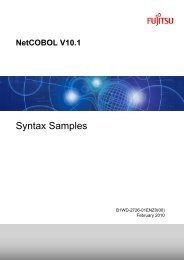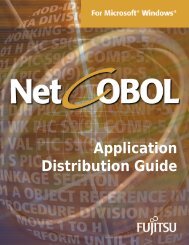NetCOBOL for SPARC Architecture SAF Subroutines User's Guide
NetCOBOL for SPARC Architecture SAF Subroutines User's Guide
NetCOBOL for SPARC Architecture SAF Subroutines User's Guide
You also want an ePaper? Increase the reach of your titles
YUMPU automatically turns print PDFs into web optimized ePapers that Google loves.
Session Management Functions<br />
Chapter 3. How to Use <strong>SAF</strong> <strong>Subroutines</strong> 21<br />
Using the session management functions enables Web applications to handle<br />
multiple requests from a specific client session (WWW browser).<br />
Function Subroutine name Usage<br />
Session<br />
COBW3_START_SESSION Starting the session<br />
management<br />
COBW3_END_SESSION Terminating the session<br />
COBW3_SET_SESSION_DATA Setting the session data<br />
COBW3_GET_SESSION_DATA Getting the session data<br />
COBW3_ALTER_SESSION_TIME<br />
OUT<br />
Changing the time of session timeout<br />
COBW3_GET_SESSION_INFO Getting the current session<br />
in<strong>for</strong>mation<br />
The session management functions cannot be used with COBOL CGI subroutines.<br />
It is possible to maintain the connection status with a specific client (WWW browser)<br />
by using the session management functions <strong>for</strong> opening the session. In a single<br />
session, the data entered on a previous page can be inherited by a subsequent page<br />
using the session data functions.<br />
WWW Browser WWW Server<br />
Screen1<br />
Screen2<br />
Screen3<br />
Web<br />
Application 1<br />
Web<br />
Application 2<br />
Session data<br />
is inherited<br />
Session<br />
start<br />
Session<br />
end<br />
A session time-out occurs when the client session transmits no data <strong>for</strong> an extended<br />
period or when the transaction is interrupted due to some reason such as the WWW<br />
browser being closed be<strong>for</strong>e completing the session .<br />
A time-out occurs when the time counted from when the Web application returned a<br />
response to the WWW browser to when the next request is issued by the WWW<br />
browser in the same session has exceeded the specified time. When a time-out<br />
occurs, the session management terminates the session leaving the application’s<br />
resources in the same status as when the session was interrupted . To cope with<br />
such a status, the session management functions provide a registration mechanism<br />
of time-out processing.







